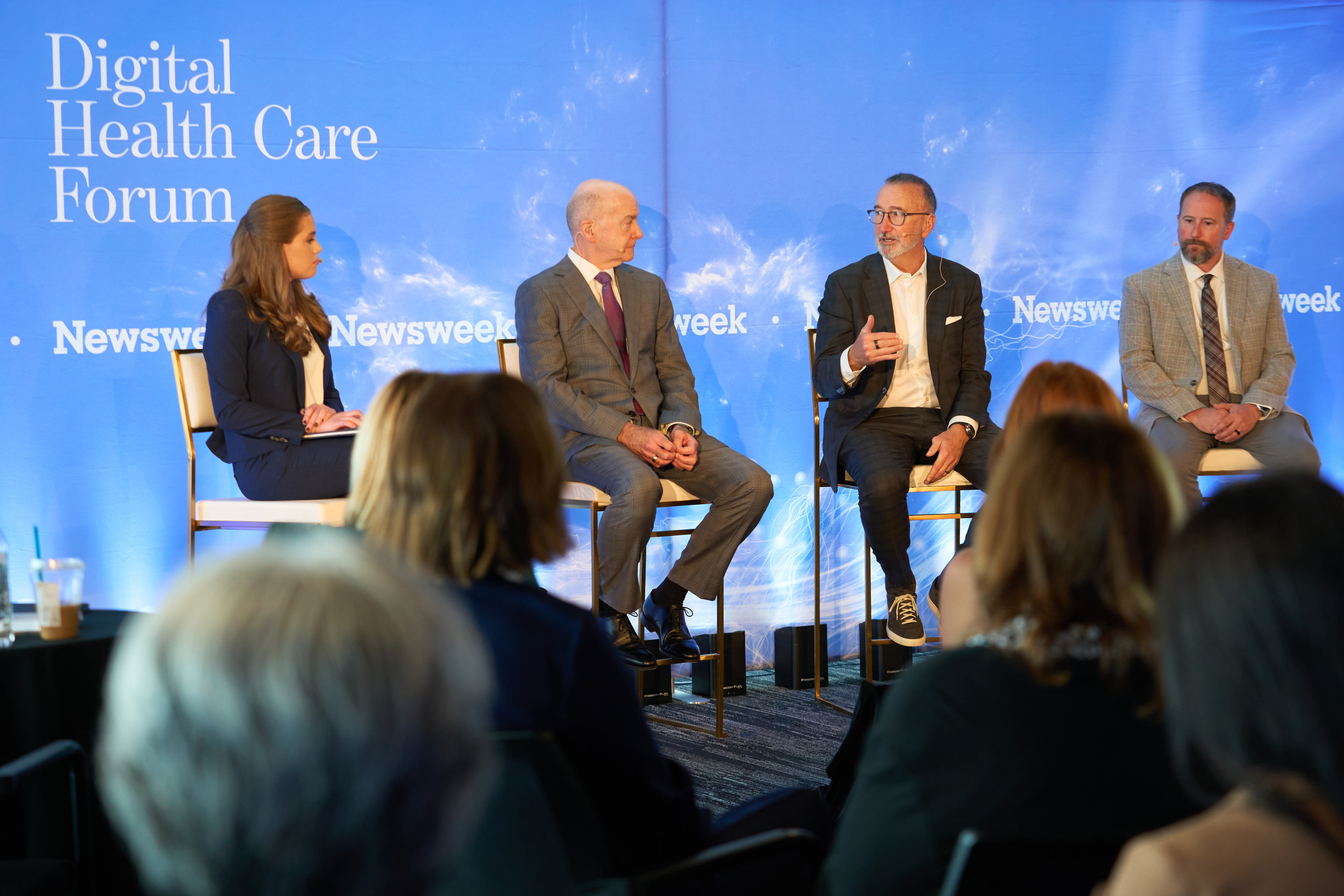
The demands on health care are growing amid aging populations, labor shortages and rising costs. To meet current demands and anticipate future challenges, hospitals around the world are moving to adopt the latest technology and embrace the digital transition.
Newsweek’s Digital Health Care Forum on Tuesday brought together leaders from across the health care industry to share insights about how to invest in new technology to provide the best care and create efficient workflows across systems.
“We want to transform health care and you can’t fully do that without fully leveraging technology,” Fairview Health Services President and CEO James Hereford said during “The Business Case for Tech and Innovation” panel.
The forum offered a full day of programming with panels, fireside chats and presentations featuring leaders from Memorial Sloan Kettering Cancer Center, Statista and UMass Memorial Health.
Newsweek’s Health Care Editor Alexis Kayser led many of the panel discussions and was joined by Newsweek’s Global Head of Research Duncan Ross on stage to share the key takeaways about the key lessons that audience members can implement in their own workplaces.
Speakers included senior leadership from Hospital for Special Surgery, UVA Health, Memorial Hermann Health System, City of Hope, Sanford Health and MD Anderson Cancer Center.
Have specific, clinician-cleared, mission-focused goals before you invest in new technologies
Every industry is feeling the pressure to implement AI. But throughout the forum, experts warned against rushing into adoption for the sake of innovation.
During “The Business Case for Tech and Innovation” panel, Sanford Health Chief Information Officer Brad Reimer said pacing out tech deployments has been a huge benefit that allows the health system to do more pilot programs, reduce risk and pivot or bail out when they aren’t getting the outcomes they want.
“That’s much harder to do if you push that across a whole physician group or a full nursing group,” he said. “[We’re] trying to make sure that we’re taking a big picture step back of how much change we are introducing to the clinicians and to operations and making sure that we’re not just peppering them with a bunch of uncoordinated things that don’t drive value.”
This approach has also helped with the recruitment of medical staff who expect the latest technology and advancements in hospitals.
Microsoft Health and Life Sciences Corporate Vice President Joe Petro also warned against chasing after “the next shiny ball.”
“The advice that I give startups is, you need to go figure out what you’re actually doing and see if you can actually produce a real outcome,” Petro said. “Because if it’s just a prompt, those are the companies of the 100,000 that basically you’ve washed up, there has to be a differentiation, there has to be an outcome producer. You really got to focus on ROI.”
Transparency and accountability are key to a successful digital health care strategy
At the start of the event, Tina Freese Deckers, the board chair of the American Hospital Association and president and CEO of Corewell Health, talked about the accountability ladder.
“You can be on the lower rungs where you can blame people, you can make excuses, you can wait and hope – don’t camp out there,” she said. “Go to those higher rungs where you find solutions, where you acknowledge the reality, where you make it happen.”
For the health care ecosystem to survive for the next ten or 20 years, she said, leaders have to embrace change and ensure their team is driving towards it.
“We’re going to have to own it. This will require hard things [and] people are not going to be happy with it, and so as we navigate through that, it can be very easy to come down on those lower runs of accountability.”
When implementing a new technology, like an AI or automation tool, organizations need to be transparent with staff, patients and partners.
“Everybody should understand what’s being used, when it’s being used, and why it’s being used, and feedback from all levels of the organization should be incorporated along the way,” Kayser said.
When choosing vendors, IU Health President and CEO Dennis Murphy said accountability and transparency have to be present on “both sides of the table.”
“We want to know if our team is not doing what they’re supposed to,” he said during his panel. “We are okay with telling vendors, but we are not as receptive about the feedback for our own team.”
Good partnerships, he added, are dynamic and go beyond financial transactions to think about what is next in the space.
“There are so many things we could do in the digital health care space, but only if we have the bravery to step up and make it happen,” Newsweek’s Duncan Ross said.
Data standardization can help bridge gaps in the health system
“The health care industry is built around siloed professions,” Ross said. “It does result in all kinds of challenges. From a data perspective, it results in silos, because our oncologists don’t necessarily talk to our EMTs, who definitely don’t talk to our nurses. And it gets more and more complicated because everyone builds silos around specialties.”
While silos are not unique to health care, they create problems when delivering optimal health care to patients.
“They come into the health care system often at some of the worst points in their lives when they’re going through incredibly difficult things,” Ross said, “so we need to not only break down the silos between different parts of our organizations, we also need to use the data to break down that silo us and the people we’re trying to help.”
Dr. Nabil Chehade, chief clinical transformation, innovation and strategy officer at The MetroHealth System, said it is difficult to navigate the existing fragmented health care system. A perfect system would have a seamless transition between virtual and in-person care. While that is far from the reality now, Chehade said health systems should be designed with the right workflow and care in mind.
AI tools are only as useful as their users
When implementing new technologies, change management is essential for a successful transition.
Chief medical and nursing informatics officers play a critical role in teaching hospital staff new systems and tools.
Dr. Shawn Griffin, president and CEO of URAC, called them “physician champions” who “talk tech to doctors and doctors to tech” to make changes in how a health system operates.
“Tech has to be based around care,” he said during the “CMIOs and CNIOs: The Missing Link in Change Management” panel, “and you need champions to be ambassadors and train them.”
Griffin adds that AI adoption brings a need for implementation and oversight skills.
“If AI is being used to guide your lawn mowers to be more efficient, it’s not a big deal,” he said. “If it’s being used to guide your chemotherapy, you’re going to care about it a little bit more.”
Adopting new technology can be daunting, but when it is done right, the result can produce significant results across health systems.
During “The Next Era of Virtual and Home-Based Care” panel, speakers boasted about how the proliferation of virtual health care has increased access to patients, especially in rural and underserved areas.
New technology, like AI, has also shown great benefits for the staff.
Jefferson Health President Dr. Baligh Yehia announced that the health system is committed to returning 10 million hours back to patients by 2028. This includes reducing the documentation burden for doctors and cutting different types of paperwork that nurses have to do.
“Our team is really gathering and rallying around this pride that we want to be able to get people back to why we enter health care, which is to help people and not to do paperwork,” he said. “And so that is our commitment, to give back 10 million hours to patients over the next three years.”



